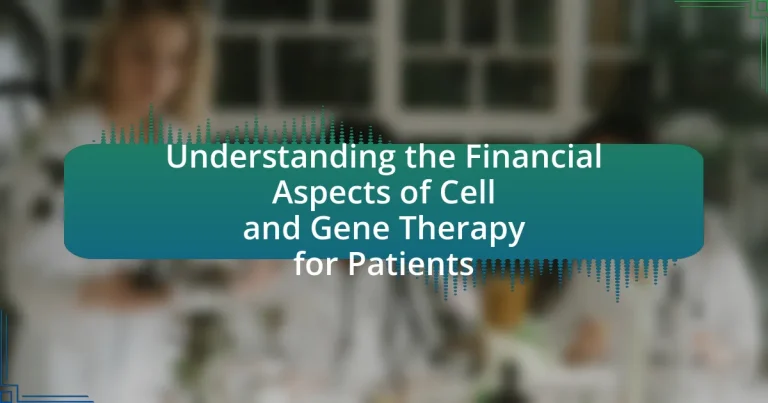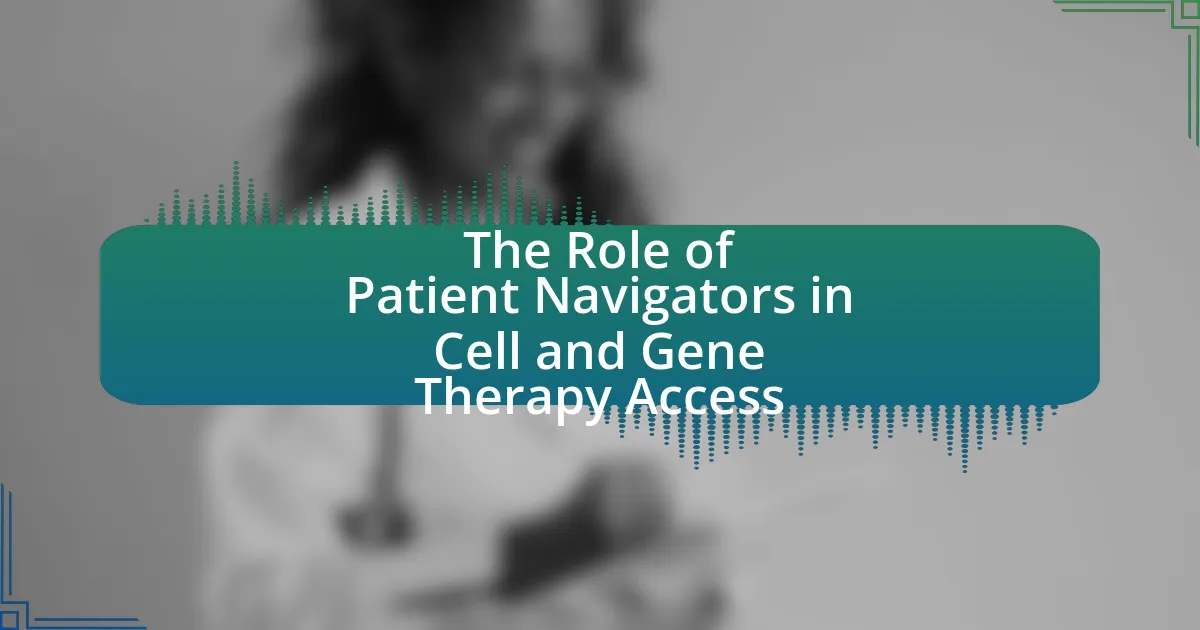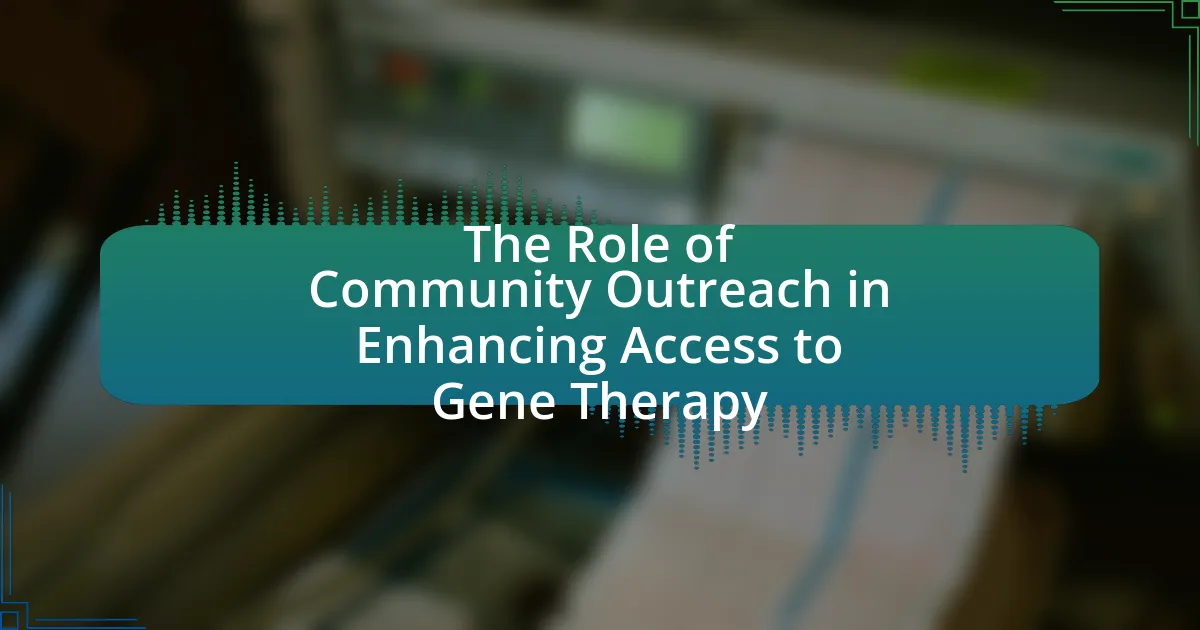The article focuses on the financial aspects of cell and gene therapy for patients, highlighting the high treatment costs, insurance coverage challenges, and long-term financial implications associated with these innovative therapies. It details the varying costs of different therapies, factors influencing pricing, and how treatment costs compare to traditional therapies. Additionally, the article explores payment options, financial assistance programs, and the potential long-term economic impacts of successful treatments. It also discusses future trends in the market, including advancements in technology and personalized medicine that may affect pricing and accessibility.
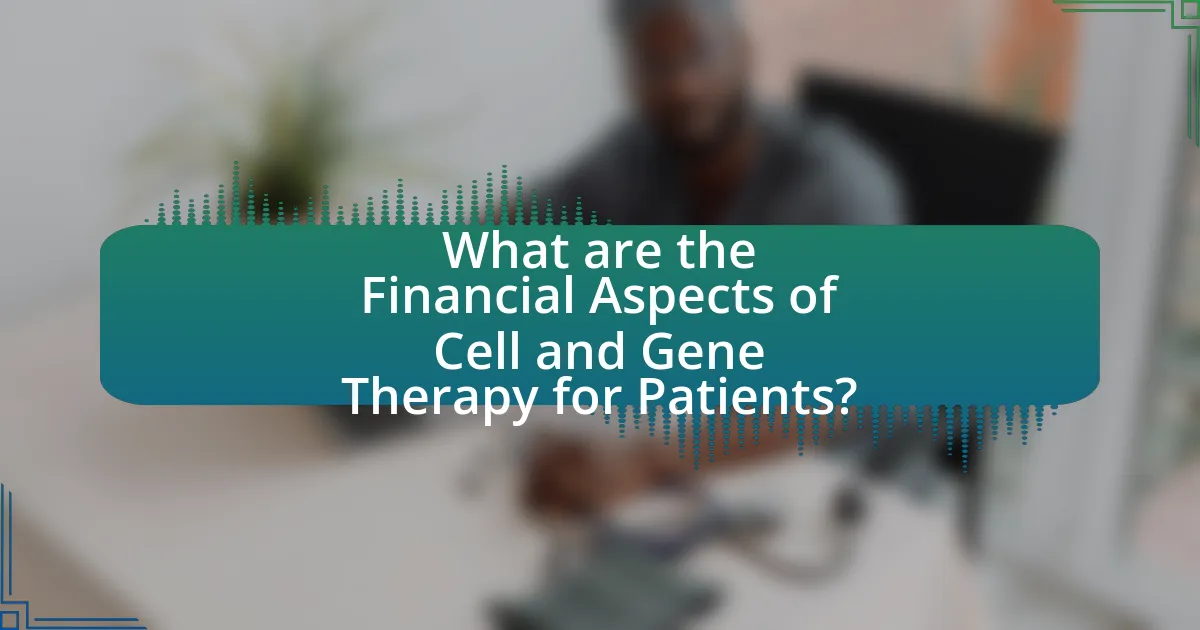
What are the Financial Aspects of Cell and Gene Therapy for Patients?
The financial aspects of cell and gene therapy for patients include high treatment costs, potential insurance coverage challenges, and long-term financial implications. Treatments can range from hundreds of thousands to millions of dollars, with specific therapies like Zolgensma costing approximately $2.1 million per patient. Insurance coverage varies significantly, with some plans fully covering these therapies while others may impose high out-of-pocket costs or deny coverage altogether. Additionally, patients may face indirect costs such as lost wages due to treatment-related absences and ongoing care needs. These financial burdens can lead to significant economic strain on patients and their families, necessitating financial planning and support resources.
How do costs vary for different types of cell and gene therapies?
Costs for different types of cell and gene therapies vary significantly based on the complexity of the treatment and the underlying technology used. For instance, autologous cell therapies, which involve modifying a patient’s own cells, can range from $373,000 to over $1 million per patient, depending on the specific therapy and associated healthcare costs. In contrast, allogeneic therapies, which use donor cells, may have lower costs, typically ranging from $100,000 to $300,000, due to streamlined manufacturing processes. Additionally, gene therapies targeting rare diseases can exceed $2 million, reflecting the high research and development costs involved. These variations are influenced by factors such as the manufacturing process, regulatory requirements, and the specific disease being treated.
What factors influence the pricing of these therapies?
The pricing of cell and gene therapies is influenced by several key factors, including research and development costs, manufacturing complexity, regulatory requirements, and market demand. Research and development costs can be substantial, often exceeding billions of dollars, as these therapies require extensive clinical trials and innovative technology. Manufacturing complexity also plays a significant role; producing these therapies often involves sophisticated processes that can be time-consuming and costly. Regulatory requirements, including the need for rigorous safety and efficacy evaluations, further add to the expenses. Lastly, market demand affects pricing, as therapies that address unmet medical needs may command higher prices due to their unique benefits and limited competition.
How do treatment costs compare to traditional therapies?
Treatment costs for cell and gene therapies are generally higher than those for traditional therapies. For instance, the average cost of a single gene therapy treatment can exceed $373,000, while traditional therapies often range from $10,000 to $100,000 per year. This significant difference is attributed to the advanced technology, research, and development involved in creating these innovative therapies, which can lead to more effective and potentially curative outcomes for certain conditions.
What payment options are available for patients undergoing these therapies?
Patients undergoing cell and gene therapies typically have several payment options available, including insurance coverage, out-of-pocket payments, and financial assistance programs. Insurance plans often cover a portion of the costs associated with these therapies, depending on the specific policy and the medical necessity of the treatment. Additionally, some pharmaceutical companies offer financial assistance programs to help patients manage out-of-pocket expenses. According to a report by the National Institutes of Health, many patients can access these therapies through various funding sources, ensuring that financial barriers do not prevent them from receiving necessary treatments.
How do insurance plans typically cover cell and gene therapies?
Insurance plans typically cover cell and gene therapies through a combination of medical necessity criteria, prior authorization processes, and specific policy provisions. Coverage often depends on the therapy’s FDA approval status, the patient’s diagnosis, and the treatment’s alignment with established clinical guidelines. For instance, therapies that demonstrate significant clinical benefits for conditions like certain cancers or genetic disorders are more likely to be covered. Additionally, insurers may require evidence of the therapy’s effectiveness and cost-effectiveness, as seen in the increasing trend of value-based agreements between manufacturers and payers, which link reimbursement to patient outcomes.
What financial assistance programs exist for patients?
Financial assistance programs for patients include government-funded programs, non-profit organizations, pharmaceutical company assistance programs, and health insurance coverage options. Government programs like Medicaid and Medicare provide financial support for eligible patients, while non-profits such as the Patient Advocate Foundation offer grants and resources. Pharmaceutical companies often have patient assistance programs that help cover the cost of medications. Additionally, many health insurance plans may cover cell and gene therapies, depending on the policy specifics. These programs aim to alleviate the financial burden associated with medical treatments, ensuring access to necessary therapies for patients in need.
What are the potential long-term financial implications for patients?
The potential long-term financial implications for patients undergoing cell and gene therapy include high treatment costs, ongoing healthcare expenses, and potential loss of income due to prolonged recovery periods. These therapies can range from hundreds of thousands to millions of dollars, which may not be fully covered by insurance, leading to significant out-of-pocket expenses. Additionally, patients may face long-term follow-up care costs and the financial burden of managing any side effects or complications that arise post-treatment. Studies indicate that the average cost of gene therapy can exceed $373,000 per patient, emphasizing the financial strain on individuals and families.
How can successful treatment outcomes affect future healthcare costs?
Successful treatment outcomes can significantly reduce future healthcare costs by decreasing the need for ongoing treatments and hospitalizations. When patients achieve effective results from therapies, particularly in chronic conditions, the frequency of medical interventions diminishes, leading to lower overall expenditures. For instance, a study published in the Journal of Managed Care & Specialty Pharmacy found that gene therapies can lead to substantial long-term savings by curing diseases that would otherwise require lifelong management, thus alleviating the financial burden on healthcare systems. This correlation between successful outcomes and reduced costs underscores the economic value of effective treatment strategies in healthcare.
What are the risks of financial burden from unsuccessful therapies?
The risks of financial burden from unsuccessful therapies include significant out-of-pocket expenses, potential loss of income due to prolonged illness, and increased healthcare costs from additional treatments. Patients may face high costs for therapies that do not yield the desired results, leading to financial strain. For instance, a study published in the Journal of Managed Care & Specialty Pharmacy found that patients undergoing unsuccessful cancer treatments can incur average costs exceeding $100,000, which may not be covered by insurance. This financial burden can lead to debt, bankruptcy, and reduced access to future healthcare options, further exacerbating the patient’s overall health and financial situation.
How can patients navigate the financial landscape of cell and gene therapy?
Patients can navigate the financial landscape of cell and gene therapy by understanding their insurance coverage, exploring financial assistance programs, and consulting with healthcare providers about costs. Insurance plans may vary significantly in their coverage of these therapies, so patients should review their policy details and contact their insurance company for clarification on what is covered. Additionally, many pharmaceutical companies and nonprofit organizations offer financial assistance programs to help offset the costs of treatment. According to a report from the National Institutes of Health, approximately 30% of patients receiving gene therapy have utilized such programs to manage expenses. Furthermore, discussing potential costs with healthcare providers can provide insights into out-of-pocket expenses and available payment plans, ensuring patients are better prepared for the financial implications of their treatment.
What resources are available to help patients understand their financial responsibilities?
Patients can access several resources to understand their financial responsibilities regarding cell and gene therapy. These resources include financial counseling services provided by healthcare institutions, which offer personalized guidance on insurance coverage, out-of-pocket costs, and payment plans. Additionally, patient advocacy organizations often provide educational materials and support networks that clarify financial obligations and available assistance programs. Furthermore, insurance companies typically have customer service representatives who can explain policy details and coverage specifics related to cell and gene therapies. These resources collectively empower patients to make informed decisions about their financial responsibilities in the context of their treatment.
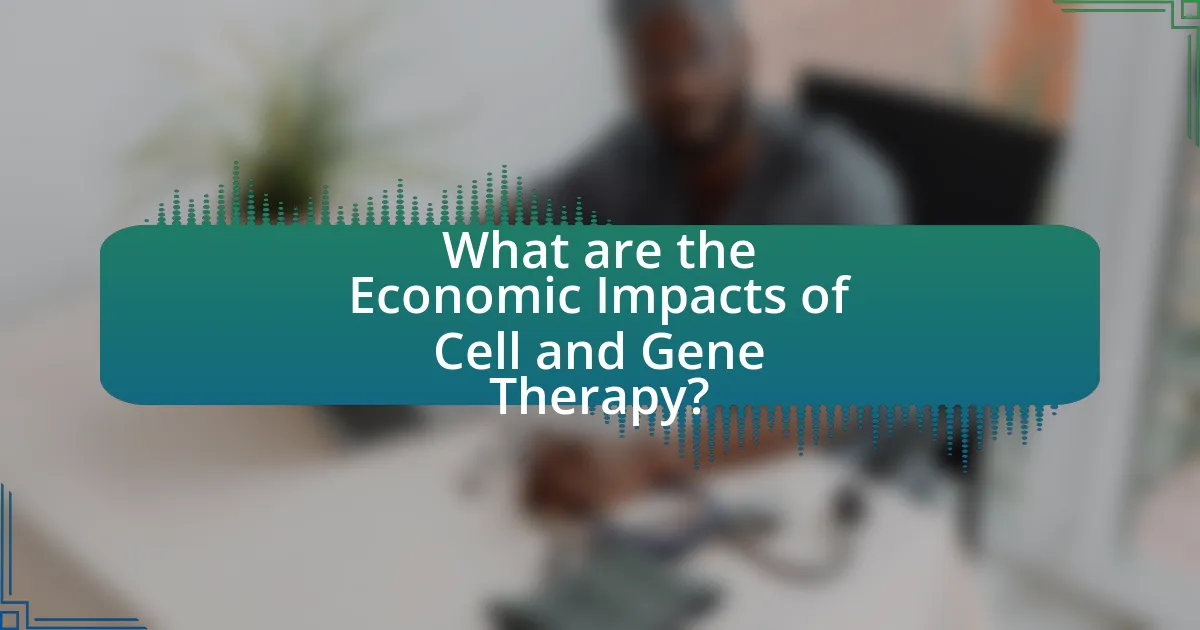
What are the Economic Impacts of Cell and Gene Therapy?
The economic impacts of cell and gene therapy are significant, primarily due to their high development and treatment costs, which can exceed $1 million per patient. These therapies can lead to long-term savings in healthcare costs by potentially curing diseases rather than providing ongoing treatment, thus reducing the burden on healthcare systems. For instance, a study published in the Journal of Managed Care & Specialty Pharmacy found that gene therapies for conditions like spinal muscular atrophy can save up to $2 million in lifetime healthcare costs per patient. Additionally, the introduction of these therapies can stimulate economic growth through job creation in biotech sectors and increased investment in research and development.
How do cell and gene therapies affect overall healthcare costs?
Cell and gene therapies can significantly affect overall healthcare costs by potentially reducing long-term expenses associated with chronic diseases. These therapies often provide curative solutions, which can lead to decreased need for ongoing treatments, hospitalizations, and associated healthcare services. For instance, a study published in the journal “Health Affairs” indicated that gene therapies for conditions like spinal muscular atrophy can lead to substantial savings by eliminating the need for lifelong care, which can cost millions over time. Additionally, the upfront costs of these therapies may be high, but they can be offset by the long-term reduction in healthcare expenditures, demonstrating a shift in cost dynamics from chronic management to one-time treatment solutions.
What is the potential for cost savings in the long run?
The potential for cost savings in the long run for cell and gene therapy is significant, primarily due to the reduction in long-term healthcare costs associated with chronic diseases. Studies indicate that successful gene therapies can lead to permanent cures or substantial improvements in health, which decreases the need for ongoing treatments, hospitalizations, and associated medical expenses. For example, a report by the Institute for Clinical and Economic Review (ICER) highlights that gene therapies for conditions like spinal muscular atrophy can save up to $1.5 million per patient over their lifetime by eliminating the need for continuous care and interventions. This demonstrates that while the upfront costs of cell and gene therapies may be high, the long-term financial benefits can outweigh these initial investments, leading to overall cost savings in healthcare systems.
How do these therapies impact healthcare systems financially?
Cell and gene therapies significantly impact healthcare systems financially by increasing upfront treatment costs while potentially reducing long-term expenses associated with chronic disease management. For instance, the average cost of a single gene therapy can exceed $1 million, which places a substantial financial burden on healthcare providers and payers. However, studies indicate that these therapies can lead to improved patient outcomes and reduced hospitalizations, ultimately lowering overall healthcare expenditures. A report from the Institute for Clinical and Economic Review (ICER) highlights that while initial costs are high, the long-term savings from decreased need for ongoing treatments and hospital care can offset these expenses, demonstrating a shift in financial dynamics within healthcare systems.
What role do pharmaceutical companies play in pricing strategies?
Pharmaceutical companies play a crucial role in pricing strategies by determining the cost of medications based on research and development expenses, market demand, and competitive landscape. These companies invest heavily in the development of new therapies, often spending billions on clinical trials and regulatory approvals, which influences their pricing decisions. For instance, a study by the Tufts Center for the Study of Drug Development found that the average cost to develop a new drug is approximately $2.6 billion. Additionally, pharmaceutical companies analyze market conditions and competitor pricing to set prices that maximize revenue while ensuring access to their products. This strategic pricing is essential in the context of cell and gene therapies, where the high costs of innovation must be balanced with patient affordability and healthcare system sustainability.
How do market dynamics influence therapy costs?
Market dynamics significantly influence therapy costs by affecting supply, demand, and pricing strategies within the healthcare sector. For instance, increased demand for innovative therapies, such as cell and gene therapies, often leads to higher prices due to limited availability and the high costs associated with research and development. Additionally, competition among pharmaceutical companies can drive prices down, as seen in markets where multiple therapies are available for the same condition. According to a report by the IQVIA Institute for Human Data Science, the average annual cost of gene therapies can exceed $373,000, reflecting both the complexity of the treatments and the market’s willingness to pay for effective solutions. Thus, market dynamics, including competition, demand fluctuations, and regulatory factors, play a crucial role in determining the costs associated with therapy.
What ethical considerations arise from pricing strategies?
Ethical considerations in pricing strategies include fairness, accessibility, and transparency. Fairness addresses whether prices reflect the true value of the therapy and do not exploit patients’ vulnerabilities. Accessibility concerns whether high prices limit patient access to essential treatments, particularly for low-income individuals or marginalized communities. Transparency involves clear communication about pricing structures and the rationale behind costs, which is crucial for building trust between providers and patients. For instance, the high cost of gene therapies, such as Zolgensma, which can exceed $2 million, raises ethical questions about equitable access and the justification of such pricing in relation to the benefits provided.
How do government policies affect the financial aspects of these therapies?
Government policies significantly influence the financial aspects of cell and gene therapies by determining funding, reimbursement rates, and regulatory frameworks. For instance, policies that support research funding can lower development costs, while reimbursement policies set by government health programs dictate how much healthcare providers are compensated for administering these therapies. In the United States, the Centers for Medicare & Medicaid Services (CMS) has established specific reimbursement rates for gene therapies, which directly impacts the affordability and accessibility for patients. Additionally, regulatory policies can either expedite or delay the approval process, affecting the market entry and pricing strategies of these therapies.
What regulations impact pricing and reimbursement?
Regulations that impact pricing and reimbursement include government policies, health technology assessment (HTA) frameworks, and pricing agreements with pharmaceutical companies. Government policies, such as the Affordable Care Act in the United States, influence how therapies are covered and reimbursed by insurance providers. HTA frameworks, utilized in countries like the UK and Canada, assess the clinical and economic value of new therapies, directly affecting their market access and pricing. Additionally, pricing agreements, such as risk-sharing arrangements or value-based pricing models, negotiated between manufacturers and payers, can significantly shape the reimbursement landscape for cell and gene therapies.
How do public health initiatives influence access to therapies?
Public health initiatives significantly enhance access to therapies by implementing policies that reduce barriers to healthcare services. These initiatives often include funding for research, subsidies for treatment costs, and the establishment of programs aimed at increasing awareness and education about available therapies. For instance, the Affordable Care Act in the United States expanded Medicaid coverage, allowing millions more to access necessary treatments, including advanced therapies like cell and gene therapy. Additionally, public health campaigns can promote preventive measures and early diagnosis, which are crucial for effective treatment outcomes, thereby improving overall access to therapies.

What are the Future Trends in the Financial Aspects of Cell and Gene Therapy?
Future trends in the financial aspects of cell and gene therapy include increased investment from both public and private sectors, leading to more affordable treatment options. As of 2023, the global cell and gene therapy market is projected to reach approximately $43 billion by 2026, driven by advancements in technology and regulatory support. Additionally, innovative payment models, such as outcomes-based pricing and subscription models, are emerging to address the high upfront costs associated with these therapies. These trends indicate a shift towards making cell and gene therapies more accessible to patients while ensuring sustainable financial returns for developers.
How is the market for cell and gene therapy expected to evolve?
The market for cell and gene therapy is expected to experience significant growth, driven by advancements in technology and increasing investment. According to a report by Grand View Research, the global cell and gene therapy market was valued at approximately $4.5 billion in 2021 and is projected to expand at a compound annual growth rate (CAGR) of around 30% from 2022 to 2030. This growth is attributed to the rising prevalence of genetic disorders, the increasing number of clinical trials, and the approval of innovative therapies by regulatory bodies. Furthermore, the expansion of manufacturing capabilities and the development of more cost-effective treatment options are anticipated to enhance market accessibility, thereby increasing patient adoption rates.
What innovations could reduce costs in the future?
Innovations such as advanced manufacturing techniques, personalized medicine, and digital health technologies could significantly reduce costs in the future of cell and gene therapy. Advanced manufacturing techniques, like continuous bioprocessing, can streamline production and lower expenses by increasing efficiency and reducing waste. Personalized medicine, which tailors treatments to individual genetic profiles, can enhance effectiveness and minimize trial-and-error approaches, ultimately lowering costs associated with ineffective therapies. Digital health technologies, including telemedicine and remote monitoring, can reduce overhead costs and improve patient management, leading to more efficient resource allocation. These innovations are supported by industry trends indicating that optimizing production and enhancing patient engagement can lead to substantial cost reductions in healthcare delivery.
How might competition among companies affect pricing?
Competition among companies typically leads to lower pricing for consumers. When multiple companies offer similar products or services, they often engage in price competition to attract customers, which can drive prices down. For instance, in the pharmaceutical industry, when several companies develop competing gene therapies, they may reduce their prices to gain market share, as seen in the case of CAR-T cell therapies where pricing strategies varied significantly among manufacturers. This competitive pressure can result in more affordable options for patients, ultimately enhancing access to innovative treatments.
What are the implications of emerging technologies on therapy costs?
Emerging technologies significantly reduce therapy costs by streamlining processes and enhancing efficiency. For instance, advancements in gene editing and cell therapy techniques can lead to more effective treatments that require fewer resources and less time to develop. A study published in the journal “Nature Biotechnology” indicates that the cost of gene therapies has decreased by approximately 30% over the past five years due to improved manufacturing processes and automation. Additionally, telehealth technologies have made therapy more accessible, reducing travel and associated costs for patients. These factors collectively contribute to a more cost-effective therapeutic landscape, ultimately benefiting patients financially.
How could advancements in research and development impact financial aspects?
Advancements in research and development can significantly reduce costs and improve the financial viability of cell and gene therapies. By enhancing the efficiency of production processes and increasing the success rates of therapies, R&D can lead to lower overall expenses for manufacturers and healthcare providers. For instance, a study published in the journal “Nature Biotechnology” highlighted that innovations in gene editing technologies, such as CRISPR, have the potential to decrease the cost of developing new therapies by up to 90%. This reduction in costs can ultimately make treatments more accessible to patients, thereby impacting the financial aspects of healthcare systems positively.
What role does personalized medicine play in future pricing models?
Personalized medicine is expected to significantly influence future pricing models by enabling more precise and effective treatments tailored to individual patient needs. This approach allows for the development of therapies that are specifically designed based on genetic, environmental, and lifestyle factors, which can lead to improved outcomes and reduced trial-and-error prescribing. As a result, pricing models may shift towards value-based frameworks, where costs are aligned with the effectiveness and efficiency of treatments. For instance, a study published in the Journal of Personalized Medicine highlights that personalized therapies can lead to cost savings by minimizing adverse drug reactions and hospitalizations, thereby justifying higher upfront costs through long-term savings.
What practical tips can patients use to manage costs associated with cell and gene therapy?
Patients can manage costs associated with cell and gene therapy by exploring financial assistance programs, negotiating with healthcare providers, and utilizing insurance benefits effectively. Financial assistance programs, often provided by pharmaceutical companies or non-profit organizations, can help cover out-of-pocket expenses. Negotiating with healthcare providers may lead to reduced fees or payment plans, making treatments more affordable. Additionally, understanding and maximizing insurance benefits, including pre-authorization and appeals for coverage, can significantly lower costs. These strategies are supported by the increasing availability of financial resources and advocacy groups dedicated to helping patients navigate the complexities of healthcare expenses.
